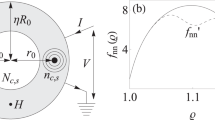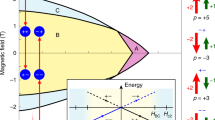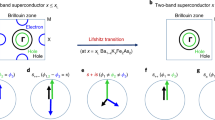Abstract
Conventional superconductors are strong diamagnets that, through the Meissner effect, expel magnetic fields. It would therefore be surprising if a superconducting ground state would support spontaneous magnetics fields. Such time-reversal symmetry-broken states have been proposed for the high-temperature superconductors, but their identification remains experimentally controversial. Here we show a route to a low-temperature superconducting state with broken time-reversal symmetry that may accommodate currently conflicting experiments. This state is characterized by an unusual vortex pattern in the form of a necklace of fractional vortices around the perimeter of the material, where neighbouring vortices have opposite current circulation. This vortex pattern is a result of a spectral rearrangement of current-carrying states near the edges.
This is a preview of subscription content, access via your institution
Access options
Subscribe to this journal
Receive 12 print issues and online access
$209.00 per year
only $17.42 per issue
Buy this article
- Purchase on Springer Link
- Instant access to full article PDF
Prices may be subject to local taxes which are calculated during checkout





Similar content being viewed by others
References
Wollman, D. A., Van Harlingen, D. J., Lee, W. C., Ginsberg, D. M. & Leggett, A. J. Experimental determination of the superconducting pairing state in YBCO from the phase coherence of YBCO-Pb dc SQUIDs. Phys. Rev. Lett. 71, 2134–2137 (1993).
Tsuei, C. C. et al. Pairing symmetry and flux quantization in a tricrystal superconducting ring of YBa2Cu3O7−δ . Phys. Rev. Lett. 73, 593–596 (1994).
Covington, M. et al. Observation of surface-induced broken time-reversal symmetry in YBa2Cu3O7 tunnel junctions. Phys. Rev. Lett. 79, 277–280 (1997).
Krishana, K., Ong, N. P., Li, Q., Gu, G. D. & Koshizuka, N. Plateaus observed in the field profile of thermal conductivity in the superconductor Bi2Sr2CaCu2O8 . Science 277, 83–85 (1997).
Dagan, Y. & Deutscher, G. Doping and magnetic field dependence of in-plane tunneling into YBa2Cu3O7−x: Possible evidence for the existence of a quantum critical point. Phys. Rev. Lett. 87, 177004 (2001).
Gonnelli, R. S. et al. Evidence for pseudogap and phase-coherence gap separation by Andreev reflection experiments in Au/La2−xSrxCuO4 point-contact junctions. Eur. Phys. J. B 22, 411–414 (2001).
Elhalel, G., Beck, R., Leibovitch, G. & Deutscher, G. Transition from a mixed to a pure d-wave symmetry in superconducting optimally doped YBa2Cu3O7−x thin films under applied fields. Phys. Rev. Lett. 98, 137002 (2007).
Gustafsson, D. et al. Fully gapped superconductivity in a nanometre-size YBa2Cu3O7−δ island enhanced by a magnetic field. Nature Nanotech. 8, 25–30 (2013).
Tsuei, C. C. & Kirtley, J. R. Pairing symmetry in cuprate superconductors. Rev. Mod. Phys. 72, 969–1016 (2000).
Carmi, R., Polturak, E., Koren, G. & Auerbach, A. Spontaneous macroscopic magnetization at the superconducting transition temperature of YBa2Cu3O7−δ . Nature 404, 853–855 (2000).
Neils, W. K. & Van Harlingen, D. J. Experimental test for subdominant superconducting phases with complex order parameters in cuprate grain boundary junctions. Phys. Rev. Lett. 88, 047001 (2002).
Kirtley, J. R. et al. Angle-resolved phase-sensitive determination of the in-plane gap symmetry in YBa2Cu3O7−δ . Nature Phys. 2, 190–194 (2006).
Saadaoui, H. et al. Search for broken time-reversal symmetry near the surface of superconducting YBa2Cu3O7−δ films using β-detected nuclear magnetic resonance. Phys. Rev. B 83, 054504 (2011).
Yip, S.-K. & Garg, A. Superconducting states of reduced symmetry: General order parameters and physical implications. Phys. Rev. B 48, 3304–3308 (1993).
Schemm, E. R., Gannon, W. J., Wishne, C. M., Halperin, W. P. & Kapitulnik, A. Observation of broken time-reversal symmetry in the heavy-fermion superconductor UPt3 . Science 345, 190–193 (2014).
Buchholtz, L. J. & Zwicknagl, G. Identification of p-wave superconductors. Phys. Rev. B 23, 5788–5796 (1981).
Hu, C. R. Midgap surface states as a novel signature for dx a2 − x b2-wave superconductivity. Phys. Rev. Lett. 72, 1526–1529 (1994).
Löfwander, T., Shumeiko, V. S. & Wendin, G. Andreev bound states in high-Tc superconducting junctions. Supercond. Sci. Technol. 14, R53–R77 (2001).
Tanaka, Y. & Kashiwaya, S. Theory of tunnelling spectroscopy of d-wave superconductors. Phys. Rev. Lett. 74, 3451–3454 (1995).
Kashiwaya, S. & Tanaka, Y. Tunnelling effects on surface bound states in unconventional superconductors. Rep. Prog. Phys. 63, 1641–1724 (2000).
Vorontsov, A. B. Broken translational and time-reversal symmetry in unconventional superconducting films. Phys. Rev. Lett. 102, 177001 (2009).
Matsumoto, M. & Shiba, H. Coexistence of different symmetry order parameters near a surface in d-wave superconductors I. J. Phys. Soc. Jpn 64, 3384–3396 (1995).
Fogelström, M., Rainer, D. & Sauls, J. A. Tunneling into current-carrying surface states of high-Tc superconductors. Phys. Rev. Lett. 79, 281–284 (1997).
Fulde, P. & Ferrell, R. A. Superconductivity in a strong spin-exchange field. Phys. Rev. 135, A550–A563 (1964).
Larkin, A. I. & Ovchinnikov, Yu. N. Inhomogeneous state of superconductors. Sov. Phys. JETP 20, 762–769 (1965).
Palumbo, M., Muzikar, P. & Sauls, J. A. Magnetic instabilities in unconventional superconductors. Phys. Rev. B 42, 2681–2683 (1990).
Sigrist, M. & Rice, T. M. Unusual paramagnetic phenomena in granular high-temperature superconductors—a consequence of d-wave pairing. Rev. Mod. Phys. 67, 503–513 (1995).
Fogelström, M. & Yip, S.-K. Time-reversal symmetry-breaking states near grain boundaries between d-wave superconductors. Phys. Rev. B 57, R14060–R14063 (1998).
Higashitani, S. Mechanism of paramagnetic Meissner effect in high-temperature superconductors. J. Phys. Soc. Jpn 66, 2556–2559 (1997).
Barash, Y. S., Kalenkov, M. S. & Kurkijärvi, J. Low-temperature magnetic penetration depth in d-wave superconductors: Zero-energy bound state and impurity effects. Phys. Rev. B 62, 6665–6673 (2000).
Löfwander, T., Shumeiko, V. S. & Wendin, G. Time-reversal symmetry breaking at Josephson tunnel junctions of purely d-wave superconductors. Phys. Rev. B 62, R14653–R14656 (2000).
Eschrig, M. et al. Symmetries of pairing correlations in superconductor ferromagnet nanostructures. J. Low Temp. Phys. 147, 457–476 (2007).
Higashitani, S. Odd-frequency pairing effect on the superfluid density and the Pauli spin susceptibility in spatially nonuniform spin-singlet superconductors. Phys. Rev. B 89, 184505 (2014).
Suzuki, S.-I. & Asano, Y. Paramagnetic instability of small topological superconductors. Phys. Rev. B 89, 184508 (2014).
Vasyukov, D. et al. A scanning superconducting quantum interference device with single electron spin sensitivity. Nature Nanotech. 8, 639–644 (2013).
Black-Schaffer, A. M., Golubev, D., Bauch, T., Lombardi, F. & Fogelström, M. Model evidence of a superconducting state with a full energy gap in small cuprate islands. Phys. Rev. Lett. 110, 197001 (2013).
Serene, J. M. & Rainer, D. The quasiclassical approach to superfluid 3He. Phys. Rep. 101, 221–311 (1983).
Nagato, Y., Nagai, K. & Hara, J. Theory of the Andreev reflection and the density-of-states in proximity contact normal-superconducting infinite double-layer. J. Low. Temp. Phys. 93, 33–56 (1993).
Schopohl, N. & Maki, K. Quasiparticle spectrum around a vortex line in a d-wave superconductor. Phys. Rev. B 52, 490–493 (1995).
Sauls, J. A. & Eschrig, M. Vortices in chiral, spin-triplet superconductors and superfluids. New J. Phys. 11, 075008 (2009).
Vorontsov, A. B. & Sauls, J. A. Thermodynamic properties of thin films of superfluid 3He–A. Phys. Rev. B 68, 064508 (2003).
Acknowledgements
We thank the Swedish Research Council (VR) via the Linnaeus Center on Engineered Quantum Systems and projects 621-2011-4299 and 621-2012-4597, as well as the Knut and Alice Wallenberg Foundation for financial support. The authors thank A. Vorontsov, J. Sauls, T. Bauch and F. Lombardi for valuable discussions.
Author information
Authors and Affiliations
Contributions
M.H. prepared and performed the numerical computations and produced all the figures. T.L. and M.F. wrote the paper and supervised the project. All authors planned, analysed and discussed the results and commented on the manuscript.
Corresponding authors
Ethics declarations
Competing interests
The authors declare no competing financial interests.
Rights and permissions
About this article
Cite this article
Håkansson, M., Löfwander, T. & Fogelström, M. Spontaneously broken time-reversal symmetry in high-temperature superconductors. Nature Phys 11, 755–760 (2015). https://doi.org/10.1038/nphys3383
Received:
Accepted:
Published:
Issue Date:
DOI: https://doi.org/10.1038/nphys3383
This article is cited by
-
Disorder-robust phase crystal in high-temperature superconductors stabilized by strong correlations
npj Quantum Materials (2022)
-
Broken translational symmetry at edges of high-temperature superconductors
Nature Communications (2018)
-
Scanned probe imaging of nanoscale magnetism at cryogenic temperatures with a single-spin quantum sensor
Nature Nanotechnology (2016)



